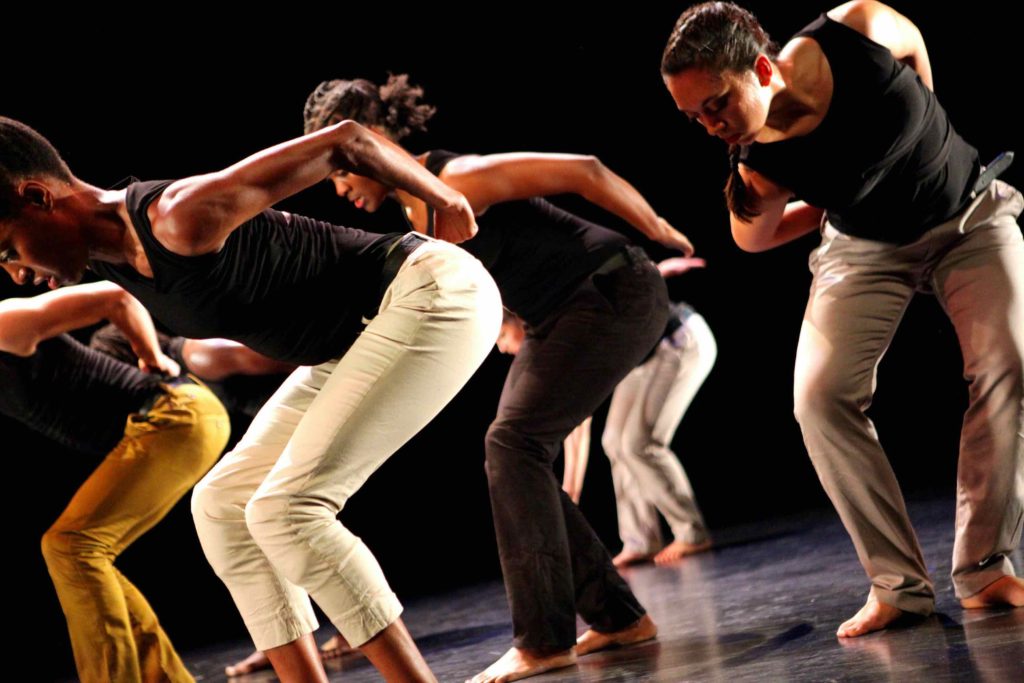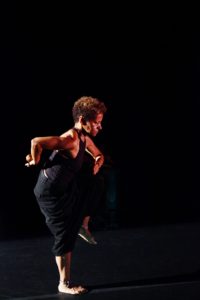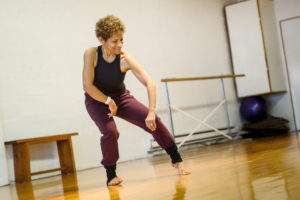Zab Maboungou: A fierce proponent of African culture in Montreal - Vancouver Ballet Society
- Home
- Features 2020 - 2023
- Zab Maboungou: A fierce proponent of African culture in Montreal

By Victor Swoboda
In the Lingala language of Congo, where Zab Maboungou passed her formative years, “nyata nyata” means stomp your feet. The phrase became the apt name of the African contemporary dance company that she founded in Montreal in 1987. From the outset and to this day, Maboungou has taught, displayed and honed not only the African dance which she was weaned on, but also fiercely insisted on the contribution of African culture to the West. Her road in Montreal was bumpy as she navigated around ruts of aesthetic and racial prejudice. But the path she blazed has brought followers who identified with her approach and were ready to share it.
Perhaps only someone of Maboungou’s background could have created and sustained an African dance company and studio in Montreal for over three decades. She was born in Paris to a French mother and a Congolese father, an engineer who was studying in France. Maboungou was a little girl when her mother died after the family had settled in Brazzaville, Republic of Congo, leaving behind Zab and her three brothers.

“I remember telling myself that I had to take care of myself because Maman was no longer there,” said Maboungou in the large downtown studio where Nyata Nyata has always operated. “I come from a matrilineal society in central Africa where the woman organizes things. In Africa at age five you already know how to take care of a child. I was organizing a lot, taking care of my brothers. I learned how to organize even though I hate being a leader,” she added in a surprising self-assessment from a recognized trailblazer.
Growing up, Maboungou absorbed a culture in which common daily actions carried a tinge of dance. “I could perceive the dance in the body. When you’re raised in Africa, that’s how we walk, the way we sit, cook. I recall walking behind a woman carrying a baby in her arms and a jug of water on her head while going up a slope. These are the things that marked me, not ballet!” she added. “Westerners were doing contemporary dance from their historical perspective. They had to fight ballet. I did not. Dance was in my [daily] life. It was not institutionalized, like in Westerners’ lives.”
While still a child, Maboungou was also absorbing the post-colonial talk she heard at home. Her father had attended school in France on a colonial grant but returned to Africa in order to contribute to the newly independent country’s growth and to participate in its politics. Hearing discussions about the future of Africa made her aware of her life within a historical context. Perhaps these discussions were the inspiration for Maboungou’s emphatic rhetorical manner of speech, at times reminiscent of a charismatic politician exhorting followers.
Like her father, Maboungou attended university in France. She undertook studies in philosophy, but dancing was always close at hand. In Paris, she took part with other Congolese in an amateur “modern traditional” dance group. Although no thoughts of a formal dance career entered her mind, she was already doing research. After visiting a friend in Montreal, she applied for Canadian residency and decided to settle here.
She found work teaching philosophy at a local junior college or CEGEP, but in her spare time, she danced at a Haitian community centre. She constantly had to explain her Congolese roots, correcting those who mistook her for Haitian or Afro-American. Sensing her skill, friends encouraged her to teach.

Her first studio was a loft on St. Laurent Boulevard in the nine-storey Cooper Building, famous since 2017 for Kevin Ledo’s huge mural of Leonard Cohen on the side of the building. At the time, other dancemakers like Marie Chouinard and Edouard Lock were also renting space there. Maboungou was juggling many duties. Simply making it to the studio on time was a trial.
“I would finish CEGEP class, change clothes in the bathroom and pick up the kids at the nursery,” she says, recalling her early years married to an American expatriate. “I realized I needed my own studio to be able to maintain this hectic schedule.”
She found her studio nearby up the same street in a former clothing factory. “An old man was there surrounded by piles of cloth. I had to find my way through. I looked at the nice floor. High ceilings. We had to be sure that the drumming wouldn’t disturb others so as a test, we brought in big drums and made as loud a noise as possible. It was May and in September, we moved in.”
As a dancer, Maboungou quickly gained fame. “Dena Davida of Tangente invited me to do a 20-minute solo, which I created using music by the Nigerian Fela Kuti, known as the King of Afro Beat. It was a mix of African and rhythm and blues. It was the only time I ever used recorded music — an homage to him.” Indeed, highly skilled live drummers — often, in later years, her son, Elli Miller-Maboungou — are essential to Nyata Nyata performances.

In 1999, Maboungou performed her solo, Incantation, at Montreal’s big showcase, Festival International de Nouvelle Danse as part of its Africa — In & Out theme. Although her performance was scheduled at 11 p.m. in the smallest room of the Monument National theatre, it was singled out among festival offerings by the Globe & Mail, the National Post, the Gazette and the New York Times, where Anna Kisselgoff called it a “mesmerizing” solo “that embodied the contemporary and the traditional on a polished intimate level.”
Her studio’s success came quickly, but at a cost. “My dance classes could not pay the rent. All my CEGEP salary went to the studio and to pay the drummers. That’s why now I have no RRSP, no chalet.”
In a move that has defined her career, Maboungou insisted on what she saw as the integrity of African dance. “Some people, both Africans and non-Africans, said that what I was doing was not African and said not to go to my classes. I was not going to give classes the way that was expected. I was building a methodology of dance. Because of that, I could not fill my classes with the kind of people who went for free outdoor dance classes on Mount Royal. I had to develop aficionados. It took 15 years to get my methodology.”
She describes her method of African dance techniques, which she calls Loketo, in her 2005 book, Heya… Danse! Central to these techniques is breathing, which she explains is a natural process that in dance relates directly to the various rhythms played by accompanying drummers. Important, too, is the basic position (feet anchored on the floor, flexed knees, loose hips and shoulders), which ensures that breathing, weight and balance are well allied. Among other aspects are how to place the feet in response to specific rhythms, how to stomp the floor, how to strike the body with the hands, working the pelvis, falling to the floor, circulatory movements, turns and the cultural importance of the circle.
These principles are taught in her two-year Artistic and Professional Training Program in Dance, which can only be undertaken following a successful audition.
Maboungou acknowledges the ritual aspect of dance as well, symbolized by a Central African mask hanging above the studio door. “When I teach, I show this mask. The ritualistic, entertaining and ceremonial aspects are all intertwined in the tradition. Sacred and profane are also intertwined. Only religions separate them.”
Maboungou’s attitude toward tradition is respectful but hardly reverential. She is analytical by nature. Even as a child, she questioned the status quo, often raising the ire of adults. “Tradition is a continuum. It always grows,” she says. “The traditionalistic approach closes you down — the past becomes the master. It can be a reference, but it’s not the sole way.”
Among young Montreal choreographers who trained with Maboungou and are now pursuing their own careers are Rhodnie Désir, Sarah Elola and George Stamos. A student of many dance techniques who was twice an invited artist at the Baryshnikov Arts Center in New York, Stamos trained in Loketo for six years and danced with Nyata Nyata across Canada.
“Loketo technique is the most sophisticated and cohesive movement technique I have studied,” says Stamos. “The way Zab has integrated multidirectional movement principles into her work is particularly inspiring. Her approach allows you to balance cooling circulating breath with intense muscular effort, and to conduct your body’s dimensions through multiple spaces simultaneously in ways that are both strengthening and sustainable.”
Stamos has used Loketo in his own choreography, most recently in One Kind Favor (2020), which included Karla Etienne, a veteran Nyata Nyata dancer.
“As I am Caucasian, it was particularly important to rigorously examine how I could utilize my interpretation of Loketo in ways that properly honour Zab and don’t unintentionally appropriate the cultural references often embedded in her teachings,” says Stamos.
Maboungou finds it ironic that even though she is a native French speaker, the federal government gave her more support and recognition over the years than Quebec’s government. Most recently, she received the 2020 Governor General’s Performing Arts Award for Artistic Achievement, a national honour that recognizes her work in enriching Canada’s cultural life and showcasing Canadian talent abroad.
“Nyata Nyata never performed in one Montreal theatre regularly — I had to self-produce. Otherwise, we toured outside Quebec at the invitation of places like Toronto’s Harbourfront. The irony was that when I applied for Quebec cultural grants, I was told that I was too international and should perform more on the local scene!”
It was only in 2019, after she was appointed as a member of the Ordre des arts et des lettres du Québec by the provincial arts agency, that Maboungou feels she began to be properly recognized by her province. In 2020, the Regroupement Québecois de la danse, a non-profit group promoting the province’s dance community, bestowed on her its first Dancer/Company of the Year award for Quebeckers of African origin.
“I had a feeling when I was a student that whether dance was going to be my profession or not, it would always be part of me,” says Maboungou. “Dance for me was a must.”

